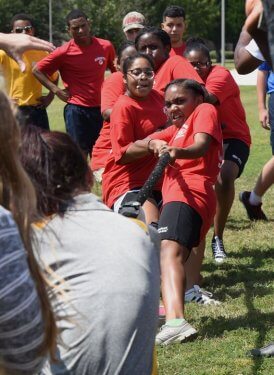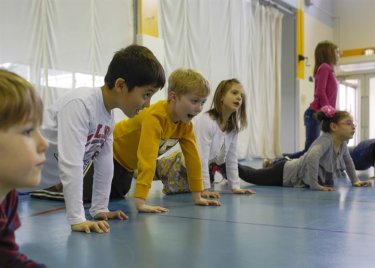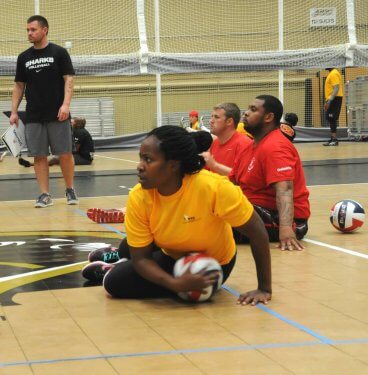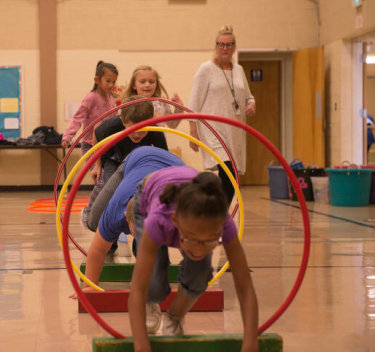The intentional practice of teaching social emotional learning (SEL) in physical education is not a new concept. In the past five years, numerous articles have been published in the Journal of Physical Education, Recreation, and Dance (JOPERD) and Strategies on the topics of SEL, cooperative learning, and the affective domain. Each article provides basic information about the topics and offers strategies and activities physical educators could do with their students to ultimately focus on a positive school climate.

Additionally, SHAPE America facilitated a two-day conference (Exploring the mind-body connection: Social and emotional learning in HPE) in July 2019. This conference was packed with 75 sessions addressing a variety of SEL topics, providing general physical educators (GPE), adapted physical educators (APE), and health educators (HE) with content and hands-on opportunities to engage with colleagues on a variety of SEL concepts (Table 1). One of the goals of the conference was to help attendees intentionally include SEL concepts in classes for the upcoming school year.
Table 1: SHAPE America Two-Day Conference on Social and Emotional Learning in HPE
| Conference Session Titles |
| Creating active social and emotional learners in health education |
| Don’t #SEL yourself short: Getting student buy-in with elementary PE |
| Self-regulation and behavior change comes from interpersonal connection |
| Supporting students with emotional behavior disabilities in PE |
| Starting a relationship with SEL |
| Bringing social and emotional learning competencies alive through skills-based health education |
The Collaborative for Academic, Social, and Emotional Learning’s (CASEL) definition of SEL is “how children and adults learn to understand and manage emotions, set goals, show empathy for others, establish positive relationships, and make responsible decisions” (‘What’, n.d., para. 1). Additionally, GPE and APE teachers must be familiar with the SEL core competencies to intentionally target them during lesson tasks and activities (‘What’, n.d., para. 2) (Table 2).
Table 2: SEL Competencies
| Self-Management | The ability to effectively manage stress, control impulses, and motivate yourself to set and achieve goals |
| Self-Awareness | The ability to know your strengths and limitations, with a well-grounded sense of confidence, optimism, and a “growth mindset |
| Social Awareness | The ability to understand the perspectives of others and empathize with them, including those from diverse backgrounds and cultures |
| Relationship Skills | The ability to communicate clearly, listen well, cooperate with others, resist inappropriate social pressure, negotiate conflict constructively, and seek and offer help when needed |
| Responsible Decision-Making | The ability to make constructive choices about personal behavior and social interactions based on ethical standards, safety, and social norms |
GPE and APE are the PERFECT environments for students to intentionally develop these skills. The connection of the SEL definition components, as well as the core competencies, also support two of the SHAPE America standards. The focus of Standard 4 is on students showing “responsible personal and social behaviors that respects and others”, and Standard 5’s focus is on students recognizing the value of physical activity for health, enjoyment, challenge, self-expression and/or social interaction” (‘SHAPE’, 2014, p. 12). Both demonstrate that GPE/APE teachers’ lessons should intentionally include SEL.

Implementing Unified Physical Education (UPE) might be one method GPE/APE teachers use to focus on SEL and school climate. “Unified Physical Education is a concept for bringing students with and without disabilities together, as equals, in a physical education setting where all students earn physical education credit, thus putting all students on equal footing” (Messerole, Tarr, & Quinn, 2019, p. 4). Philosophically, whether one is teaching a UPE course or infusing the concepts of UPE into existing physical education courses, the outcome should be the same – all classmates working toward mastery of the national or state physical education grade-level outcomes through a variety of curricular units.
As in any other GPE or APE course, the role of the teacher is critical in supporting all learners with the traditional physical education content. In addition, the teacher should focus on the SEL core competencies. “An effective Unified Physical Education course provides students with and without disabilities, the opportunity to develop physical literacy while also fostering an environment of respect and acceptance of all people. As with all school-based physical education, the goal is to develop physically literate movers for a lifetime” (Tarr, 2019, para. 9).
 Unified Physical Education is a soul-filling and life-giving course for all students, and has changed the way I teach Social Emotional Learning in the gym (J. Heebink, personal communication, September 14, 2019). In addition to teaching physical education content, students also learned about disability awareness, social justice, inclusion, inclusive youth leadership, co-leadership, advocacy, fitness, recreation/leisure, and community skills. As a result of putting a huge emphasis on SEL and building up a respectful community, several awesome stories with amazing experiences occurred from the UPE course. For example, on a snow tubing trip, students on the bus were talking about their classmates as if they were the best of friends; this interaction was my first observation that our school community was changing (J. Heebink, personal communication, September 14, 2019).
Unified Physical Education is a soul-filling and life-giving course for all students, and has changed the way I teach Social Emotional Learning in the gym (J. Heebink, personal communication, September 14, 2019). In addition to teaching physical education content, students also learned about disability awareness, social justice, inclusion, inclusive youth leadership, co-leadership, advocacy, fitness, recreation/leisure, and community skills. As a result of putting a huge emphasis on SEL and building up a respectful community, several awesome stories with amazing experiences occurred from the UPE course. For example, on a snow tubing trip, students on the bus were talking about their classmates as if they were the best of friends; this interaction was my first observation that our school community was changing (J. Heebink, personal communication, September 14, 2019).
Additionally, by doing something as simple as a ‘walk-and-talk’ at the beginning of class, students with and without disabilities have the opportunity to develop bonds with classmates (L. Smith, personal communication, September 16, 2019). At the beginning of the semester, the ‘talk’ prompts were provided by either the GPE/APE teacher or in collaboration with the speech-language pathologist; but, within a few weeks, the students independently started their own conversations during the ‘walk-and-talk’ portion of the UPE class. The increased communication spilled out of the gymnasium and into the hallways as students (with/without disabilities) were often seen together at their lockers and in the hallways. Finally, as students’ self-confidence increased, many school personnel saw an increase in students participating in school-wide clubs and groups, and in numerous activities within the school environment (L. Smith, personal communication, September 16, 2019).

The SEL competencies that students develop in Unified Physical Education can be the beginning step in impacting school climate. The ultimate goal for focusing on SEL in GPE and APE is for students to become more skillful in using SEL techniques and practices for themselves, and then hopefully, expanding their SEL practices with others in the school setting. By honing these SEL practices, students can develop a school climate that is accepting and welcoming of EVERYONE. Once a school setting is welcoming and accepting of everyone, the next step would be to support students, staff, and faculty as they transfer their SEL skills and competencies out into their communities.
If you would like additional information on Unified Physical Education, check out the resources on SHAPE America’s website (https://www.shapeamerica.org/search-results.aspx?q=Unified%20Physical%20Education). Additional information SEL can be located on CASEL’s website (https://casel.org/).
References
Messerole, M. J., Tarr, S. J., & Quinn, B. (2019). Unified physical education resources (2nd ed.). Retrieved from http://media.specialolympics.org/resources/community-building/youth-and-school/unified-champion-schools/Unifed%20Champion%20School-Unified-Physical-Education-Resourcesv2.pdf?_ga=2.87557085.414026992. 1565010701-557370348.1547143351
Society of Health and Physical Educators [SHAPE] (2014). National standards & grade-level outcomes for K-12 physical education. Champaign, IL: Human Kinetics.
Tarr, S. J. (2019, June 19). Unified physical education part 2: Simple strategies to get started [blog post]. Retrieved from https://blog.shapeamerica.org/2019/06/unified-pe-part-2/
What is SEL? (n.d.). Retrieved from https://casel.org/what-is-sel/
